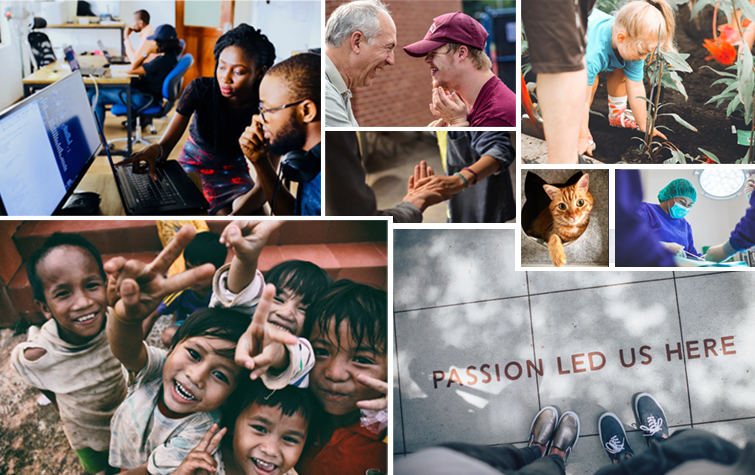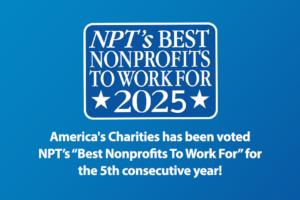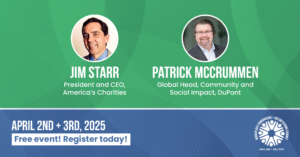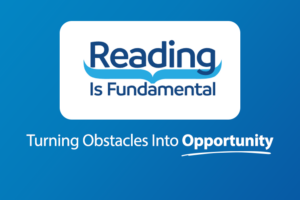Sarah Ford | October 11, 2022
Transformational Workplace Giving Programs Increase Employee Engagement and Participation
Unsplash photos courtesy of @goian, @frolleinandersen, @larm, @nathananderson, @heylagostechie, @annaelizaearl, and @walre037.
Want to start an employee giving campaign? Contact us now to learn more how we can help you put your campaign plans in motion.
How happy are you with your company’s workplace giving results and employee participation rates? Could you be happier? Then it’s time to rethink your approach to employee giving and workplace fundraising.
The simplicity of payroll deduction makes employee giving practically effortless. But simplicity does not preclude connectivity. When you fail to connect employees to why their donations matter, you end up with transactional, rather than transformational, giving experiences. However, if you give employees access to support causes they are passionate about and connect them to the personal stories and social issues behind their favorite nonprofits’ work, you end up creating those ‘aha’ moments that transform employees from one-off fundraiser participants into passionate, repeat workplace donors, cause champions, and brand ambassadors.
Why would a company seek out those ‘aha’ moments? Because it improves the culture, the company, and the community. America’s Charities has helped organizations set up and manage workplace giving programs for more than 40 years, and we’ve seen it time and again: when an employer empowers its workforce to follow their passions – when employees feel they have the agency to improve the world around them – things get better. There is a direct correlation between workplace giving and increased recruitment and retention, higher employee satisfaction, a more intentional culture, better brand recognition and reputation, increased revenue, and more.
In addition, giving back has become the norm in modern workplaces. Part of that is because of changing demographics. According to payment app Zelle’s Consumer Payment Behaviors report, nearly three out of four millennials have sent some kind of financial aid to family or friends or donated to a nonprofit since the COVID-19 pandemic began. That’s the highest rate among any generation polled, with Generation Z right behind them with the second-highest giving rate of 66 percent. A survey conducted by Fidelity Charitable shows that millennials “give more than twice as much of their money and time to charitable causes as either Baby Boomers or Gen X.”
That generosity doesn’t stop at home. A recent Deloitte survey indicates this younger generation of professionals wants the option to give through charitable giving programs sponsored by their employer. The survey reveals, “Nearly 6 in 10 (58%) of young professionals aged 18-34 gave through a workplace program in 2020, compared to only 37% of all professional donors. They also increased their workplace donation amounts in response to COVID-19 at a higher rate (35%), compared to all professionals (28%).”
Of course, older generations are socially conscious as well – that prize doesn’t just belong to millennials and Gen Zers. America’s Charities has conducted Snapshot research for more than a decade and the data is clear: every generation has shown an interest in supporting causes they care about and improving the world around them. We looked at the data from our Snapshot Employee Donor Research survey every way we could and found that Baby Boomers and Gen X alike wanted the opportunity to give at work as a means of paying it forward and connecting with their colleagues.
The new norm isn’t just because of demographics, either. Much of the reason workplace giving has become an expectation is because the divide between our personal and professional lives has become blurry. With the advent of smartphones, the ubiquity of social media, and the popularity of apps that sync and streamline every corner of our lives, we no longer see our work as separate, and often unequal, to the rest of our lives. That feeling was only reinforced when much of the world shifted to working and giving remotely during the COVID-19 pandemic.
So – we know workplace giving is powerful and we know employees of all ages and creeds want and expect the opportunity. But which program elements will bring about the most dramatic change among employees?
Elements of Workplace Giving Programs That Bring About Transformation and Social Impact
You know that quote “Give a man a fish and you feed him for a day; teach a man to fish and you feed him for a lifetime?” It’s the same with giving. Ask employees to give and you’ll see a handful of disparate, one-off transactions — but empower employees to learn about, connect with, and give to the causes that interest them, and you’ll have yourself a team championing your company’s community involvement and collectively making an impact that matters.
If you implement even just a few ideas outlined below (listed in no specific order), your workplace giving program will transform; you’ll see better results year after year.
Don’t forget: America’s Charities can make it easy for your company to integrate any or all of these ideas into your employee giving program! Whether you’re looking for an online giving solution, want to understand best practices, or are simply looking for thought leadership, we’ve got you covered. We’ve spent more than 40 years of experience in this field, so we know what’s new – and what’s tried and true – when it comes to transformational employee giving.
The best practices shared here are focused on payroll deduction donations. For information about integrating volunteerism, employee assistance relief funds (EAFs), and other giving components into your workplace giving and broader social responsibility and ESG (Environmental, Social, and Governance) programs, check out our library of free resources.
(1) Access and Awareness Make All the Difference
Employees cannot give through your workplace giving program if you don’t offer one. According to Deloitte, “just 37% of professionals who donated in 2020 leveraged a workplace giving program. More than one-third (34%) of these professionals had not donated in this way the year prior – which may indicate a growing interest in, or increased access to, charitable giving options in the workplace.” To be clear, a single fundraiser that brings your team together one time is not what we refer to as a workplace giving program. If you think you have a workplace giving program, but aren’t sure, here is a quick refresher on what a workplace giving program is.
If you have a workplace giving program, then you should examine how you are communicating about it. It’s possible a large portion of your employees simply do not know about this amazing employee benefit and efficient way to donate (more about communications in #3 below).
When asked why they didn’t donate through their employer’s workplace giving program, Deloitte’s survey reported that “17% of professionals cited a lack of awareness that such a program existed at their company, demonstrating a greater need for communication between employers and professionals about workplace giving options available to them.”
(2) Make Giving Easy and Convenient
There is a reason why so many use payment sites like Venmo, PayPal, and Zelle to send or receive money, just as why so many fundraisers are held on social platforms like Facebook Fundraisers or Eventbrite. It’s not necessarily that those methods are cheaper for the donor or better for the nonprofit recipients; it’s that they are convenient. After donors do the initial work of entering their credit card or banking information, they can have that information saved on their computer or mobile device, making future giving as easy as a click of the button. Payroll deduction giving is just as easy (easier actually) for employees! All they have to do is log into your company’s workplace giving donation site, also known as a giving portal. America’s Charities supports multiple types of login options, including Single Sign-on (SSO), which makes logging in super easy and secure for employees. Once employees are logged in, all they have to do is find the charities they want to support and submit how much money they want to be deducted from their paycheck. That’s it.
Entering personal credit card or sensitive banking information is not necessary (nor are the associated fees). And by working with a partner like America’s Charities, not only do your employees get an immediate email acknowledging the donation for tax and budgeting purposes, but they also get a handy donation summary right before tax season starts, so it’s at the top of their inbox, making it easy for them to claim eligible charitable tax deductions (no need to filter through old emails or sort through paper receipts).
Of course, if your employees want to donate through credit card or other means, we do offer those capabilities as well. What’s important is that you make the donation options available to employees secure and convenient.
(3) Meet the Moment and Don’t Underestimate the Power of Charitable Giving Options
It’s important to ensure employees can find and donate to causes and organizations that are personal to them. It’s simple: when presented with a charitable choice, employee participation in your workplace giving program increases. Conversely, lack of choice is why people do NOT give. In fact, 30 percent of employee donors we surveyed for our America’s Charities Snapshot Employee Donor Research said they do not give through the workplace because the causes they care about are not available in their employer’s giving program. America’s Charities vets charities to ensure that they are legitimate, fiscally sound, and perform the services stated – as long as charities meet these standards, we recommend you provide as broad a list of charities as possible.
In addition to allowing employees to support charities close to their hearts, invite them to support specific causes that align with your organization’s social responsibility and philanthropic goals. That could mean you feature a handful of charities that address a specific cause, or perhaps many charities that focus on specific UN Sustainable Development Goal (SDG). Whatever your company’s core focus areas are, be sure to find charities that align with it.
For companies interested in year-round employee engagement, this might come in the form of special cause-focused matching gift campaigns that include a special incentive such as the employer matching donations dollar for dollar (more on matching gifts in #6 below). We know from our Snapshot Employee Donor Research that 70 percent of employees believe it is imperative to work for an employer whose mission and values align – so it’s not about limiting choice – it’s about getting your workforce interested in your own philanthropic purpose. Employees are increasingly holding themselves and others accountable for society’s most pressing issues, and they are looking to their employers to facilitate social impact. We make it easy for you to hold cause-specific campaigns, match employee donations, track goals, and report your impact against your organization’s social responsibility and giving efforts.
Meet the moment by paying attention to current national and global events and find ways that your company can support employees’ interest in those issues. For example, offer a special giving opportunity when a natural disaster strikes, or survey your employees and find out which causes they care about most, then celebrate when the nation is paying attention to it, such as Earth Day or Child Abuse Prevention Month. You’re welcome to use our Cause Calendar, a list of causes most commonly celebrated each month of the year. And remember, the issues that are important to employees today may be very different next year or five years from now, so it’s important to listen to your workforce and keep your cause initiatives relevant and focused on what your employees care about.
(4) Technology Alone is Not Enough; Human Touch and How You Communicate Matters
Great technology can make your program run more smoothly, simply, and efficiently. As helpful as it is, however, we all know technology can be supremely frustrating as well. The fact is, there is no substitute for the human touch and good communication. Passive campaigns that use the best technology available are still doomed to fail because they provide a transactional experience at best.
Before launching your program, put together a thoughtful communications plan that goes beyond the initial campaign kick-off announcement. After letting employees know your donation site is live and inviting them to visit the portal to give to causes they love, keep sharing ongoing educational messages and stories to keep employees engaged and informed. America’s Charities provides clients with a communications toolkit full of templates and ready-to-use messages to make it seamless for your team to engage employees beyond your campaign launch.
Make sure employees know about the different ways they can donate so they can pick a payment method they are comfortable with, and make sure they understand basic concepts like what payroll deduction giving is and what makes payroll giving so efficient and valuable for them and the nonprofits they are supporting. Here are seven facts about workplace giving effectiveness to help you get started.
Moreover, share examples and stories of how their donations can make a difference. This means going beyond how much to donate and to which charity; you need to share why the donation matters. Take the following two charity impact statements for example – which one would you find most compelling?
Charity Impact Statement #1:
“By donating just $2 per paycheck ($52 total over the course of one year), your donation pays for the paint needed to paint the trim and walls in XYZ youth homeless shelter.”
Charity Impact Statement #2:
“By donating just $2 per paycheck ($52 total over the course of one year), your donation pays for the paint needed to paint the trim and walls in XYZ shelter that helps homeless youth get their GED and learn basic skills, helps them find a job, and gets them off the streets. The greatest barrier to the kids’ success is their belief that they deserve it. The most important message we can give them is that they have value and are worth it. When we paint the trim in each bedroom, we’re reinforcing that message. Your donation helps not just paint the trim – but lets these kids know they have value and dignity.”
Both examples above are good at communicating what your donation can help make possible, but example #2 paints a picture (pun intended) of how your donation will transform the lives of the youth who are being helped by the homeless shelter.
Example charity impact statements like this could easily be done via email, but make sure you leverage as many different distribution channels as you can. Think outside the email inbox! Not all employees have easy or regular access to email, and those who do have access to email are often so inundated with email messages that your message – as inspirational as it may be – could be overlooked.
Some additional places and touchpoints to consider leveraging include:
- Charity fair/guest speaker (invite representatives from charities to speak with your employees virtually or in-person – America’s Charities can help connect you with our own 100+ charity members if you’re looking for a place to start)
- your workplace giving site (pull employees into the donation site itself by using storytelling features and functionality that are built into the platform – America’s Charities can help you use our workplace giving solutions to do this)
- employee portal/company intranet
- company newsletter
- social media
- popup banners in the lobby where employees enter your building
- flyers/posters in shared workspaces
- tent cards on cafeteria tables
- digital messages displayed on your lobby or breakroom TV
- all-staff/team meetings (in-person or virtual)
- new employee onboarding/welcome packets
- employee benefits fair/open enrollment materials
(5) Safeguard Employee Confidentiality Without Impeding Nonprofit Relationships with Donors
Beyond hearing messages from you, encourage employees to connect with the charities they are supporting. One of the easiest ways to facilitate this type of connection is to encourage employees to opt-in to have their donation acknowledged by their designated nonprofit. By permitting charities to thank them, employees open the door for those charities to form deeper relationships by sharing specific stories about the people who were helped by that employee’s donation, inviting the employee to volunteer or attend events where the employee can see first-hand the impact their support makes, as well as to empower the employee to stay updated on how the nonprofit is operating and being a good steward of the donor’s financial support.
None of that will happen though if your employees don’t understand how donation acknowledgment works and why it’s so important for them to opt-in when they donate through your workplace giving program. Usually, the reason why a donor decides NOT to opt-in is for fear of how and with whom their contact and pledge information will be shared.
Every effort should be made to keep employees’ pledge information confidential and to have as few eyes as possible see their donation information. But you also don’t want that confidentiality to hinder your campaign’s fundraising performance or keep nonprofits from being able to communicate and thank donors. Employees should be reassured that the information they share on pledge forms and through the online giving website will be kept confidential. America’s Charities’ workplace giving solutions have different features and functionality designed to help employers address all of this.
For example, various coordinator and administrator user roles help our clients restrict who has access to donor pledge information. Someone from your company’s payroll/HR team will need to have permission to view limited data in order to process recurring payroll deduction donations, but the campaign coordinator doesn’t necessarily need to access that information. Something your campaign coordinator will want access to is an easy way to send reminders out to employees who started the donation process but need a little prompt to go in and complete their pledge. America’s Charities’ workplace giving solutions can do that. Likewise, our solutions make it clear and easy for employees to understand how their donation information will be shared with a nonprofit if they choose to share that information with their designated charities. Using FAQs posted on a page on the donation site, tooltips that appear when a donor hovers their mouse cursor over text during the donation process, and clear instructions and descriptions embedded in the donation process itself can all help make it clearer to employees what (if any) information is being shared and with whom.
America’s Charities doesn’t stop on the employer and employee giving side of things either. As a nonprofit ourselves (America’s Charities is a 501c3 nonprofit), we understand the challenges nonprofits experience when it comes to receiving money and donor information. After nonprofits receive donations from employees who participate in the workplace giving campaigns we manage, those nonprofits are given access to our charity reporting site where they can view contact information to thank donors who have opted-in to share their contact information with select charities. They can even see information like if an employee has made a donation in honor of a loved one or wishes to have their funds used for a specific program or purpose. Through our charity reporting site, donor confidentiality is our top priority while making sure nonprofits have the tools and information necessary to appropriately connect with employees who want to form a deeper relationship and remain updated on how their donations are helping provide solutions to real-world problems.
(6) Use Incentives to Your Advantage and to Turn Employees into Repeat Donors
Offering employees the opportunity to give through the workplace is already an incredible benefit in and of itself. 55 percent of employees would choose to work for a socially responsible company, even if it meant a lower salary. So your employees are already motivated to rally behind your company in supporting the community and being a force for good through activism.
But an effective way to further demonstrate your company’s commitment to supporting its employees and amplifying the impact of nonprofits in your community is by offering incentives such as:
- Matching gifts: A little incentive can yield huge dividends for the program and your people’s level of engagement. In fact, 84 percent of donors say they’re more likely to donate if a match is offered, and one in three say they would give a larger gift if matching is applied to their donation. There are several ways to set up a matching gift program, so be sure to read our matching gifts guide to design your program to fit your employee culture and organization’s capacity and budget.
- Gamification: To stay driven, employees need a sense of value and purpose. Associating behaviors with recognition turns them into habits. With gamification, you can instantly reward employees for taking certain actions and accomplishing specific goals that align with your company’s giving goals. Incentives can range from things like winning lunch with the CEO or earning a prized parking spot or be as simple as a badge (think modern-day certificate of recognition). For example, an employee who cares a lot about literacy could be given a “book worm” badge after they donate to literacy-focused charities. Or, if an employee participates in your special #GivingTuesday fundraiser, you could give them a “local hero” badge. To connect engagement with participation and giving, you might offer badges for employees who reach a certain fundraising level or recognize employees who volunteer time to help coordinate your company’s workplace giving campaign.
There is a lot of room for creativity and fun when it comes to designing your incentive program. The key thing is to take a step back and understand:
- what is important to your employees,
- what unique ways can you thank and recognize them for participating in your program,
- how can you best inform them about your program’s incentives so they know how to leverage them, and
- how do you effectively connect all the incentives and donations back to actual collective impact and results to ensure employees know the meaning their support provides and continue participating in your program year after year as a reliable, repeat donor nonprofits can depend on.
(7) Keep it Simple and Don’t Feel Like You Have to Reinvent the Wheel
There are endless ways you can structure your workplace giving program in terms of donation payment methods, charities available to support, the duration of your campaign, other types of giving like volunteering, employee incentives like matching gifts, and a host of other variables. Don’t overwhelm yourself by trying to do everything all at once. You can build your program over time, giving your team time and capacity to do it strategically and effectively. Choosing a full-service partner like America’s Charities to help you set up and manage your workplace giving campaign will save you a lot of time and frustration, and will give you access to online giving technology solutions, resources, best practices exclusive to clients, a proficient charity vetting and charitable funds distribution partner, and a team of experts to guide you from start to finish (and beyond).

Get Resources and Insights Straight To Your Inbox
Explore More Articles
For Fifth Consecutive Year America’s Charities Named ‘Best Nonprofit To Work For’
Washington, D.C. – April 1, 2025 – America’s Charities, the nonprofit that mobilizes the power of giving as a leading provider of volunteering, workplace giving,…
Read ArticleWorkplace Fundraising + Volunteering Summit (April 2nd and 3rd, 2025)
Join us in attending this virtual summit! The America’s Charities team is joining up with other leading voices in the workplace giving space for a…
Read ArticleThe Time to Act is Now
The results of the 2024 National Assessment of Educational Progress (NAEP) are in, and the findings are, in a word, heartbreaking. This assessment serves as…
Read ArticleGet Resources and Insights Straight To Your Inbox
Receive our monthly/bi-monthly newsletter filled with information about causes, nonprofit impact, and topics important for corporate social responsibility and employee engagement professionals, including disaster response, workplace giving, matching gifts, employee assistance funds, volunteering, scholarship award program management, grantmaking, and other philanthropic initiatives.




